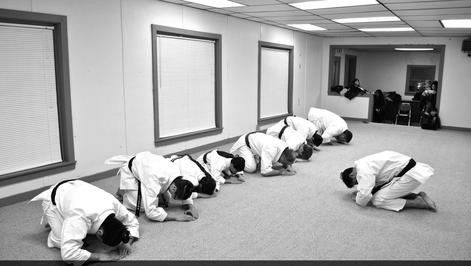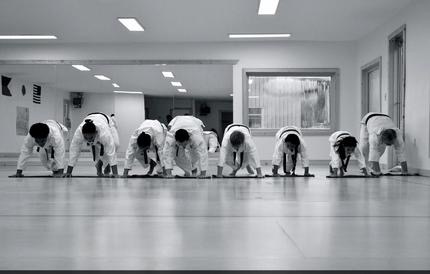

Etiquette:
The dojo is understood to be a special space, different from the other places of day-to-day experience. Dojo etiquette and protocol reflect our respect for tradition, our commitment to train together diligently, and our readiness to focus all our attention on the work at hand. It is important to learn these protocols, follow them, and contemplate their meaning.
Be prompt. Arrive before class begins. If you come in late, be seated by the door and wait for permission to join the class.
Always bow. When entering or leaving the dojo. Direct your bow to Shomen (front wall of the dojo). Sho means “true” and men means “face”. When bowing to a higher rank the lower rank bows first, does not look at the higher rank, & does not straighten up until they have. Acknowledge the presence of Senseis (teachers) with the greeting “OSS”.
Behave appropriately in the dojo. Remove your shoes before entering. Speak quietly and maintain an attitude appropriate for serious practice. Eating, drinking and chewing gum are not permitted in the dojo. No jewelry should be worn during practice.Behave appropriately in the dojo.
GI. Gi (uniform) should be clean and in good condition at all times. Never throw or drag your obi (belt) on the ground. Your obi is a symbol of your spirit.
Senpais. (senior students) are expected to set a good example for Kohais (junior students), protect them from injury, help them learn and treat them with respect and consideration.
Kohais. Kohais are expected to look to Senpais for guidance, and treat them with respect and consideration. Sit and stand when your Senpais do; always sit to the left side of Senpais.
Prevent Injury. To prevent injury, do not teach new techniques or kata to other students unless asked to do so by your Sensei.
Be Prepared. Always come to class prepared and with a clear mind. Never lose your temper during practice.
Be Attentive. Pay attention; it is part of your training. Concentrate fully on KarateDo while you are in the dojo.
Early Dismissal. If you have to leave before class ends, please notify the Sensei before the class begins. Also, if you know that you will not be able to train for a lengthy period of time you must inform your Sensei ahead of time.
During Class. During class when the Sensei demonstrates a technique for practice do not talk or walk around, sit quietly and attentively in seiza.
Asking Question. If it is necessary to ask a question to the Sensei, you should go to him or her and bow respectfully. Never call the Sensei over to you.
OSS. When the Sensei addresses you in class always acknowledge that you have heard what he/she has said by saying “OSS Sensei”. This is a way to show appreciation that your Sensei has taken an interest in making sure that you are carrying out a technique correctly. Senseis should not be ignored in class.
Always Practice. Practice your Kihon waza and kata consistently outside of class, even if it is just for a few minutes every day. This is the only way to improve your skills and physical conditioning.
Be Respectful. As a karateka you should always conduct yourself in a respectful manner by following the Dojo Kun. You should always treat others as you would want to be treated.
Although there seem to be many forms of etiquette to remember, they will come naturally as you continue to train. Please do not resent it if you are corrected on a point of etiquette, for each one is important to your safety and to the learning experience.